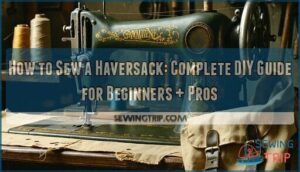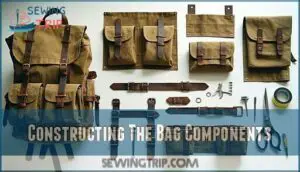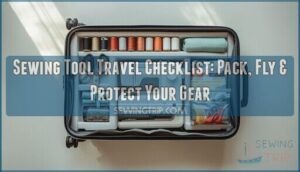This site is supported by our readers. We may earn a commission, at no cost to you, if you purchase through links.
 Learning how to sew a haversack starts with cutting your canvas or duck cloth into the main body, flap, and strap pieces.
Learning how to sew a haversack starts with cutting your canvas or duck cloth into the main body, flap, and strap pieces.
You’ll reinforce stress points with interfacing, then sew strong flat-felled seams to connect the components.
Install brass buckles or D-rings for adjustable straps, ensuring they’re securely attached with bartacking or hand-stitching.
The key lies in choosing heavy-duty thread and using a size 16 needle that won’t break under pressure.
Your machine’s tension settings matter more than you’d think – too loose and your seams won’t hold a weekend’s worth of gear.
Master these fundamentals and you’ll discover advanced techniques for creating truly bulletproof outdoor gear.
Table Of Contents
Key Takeaways
- You’ll need heavy-duty materials like canvas or duck cloth paired with strong polyester thread and a size 16 needle to handle the fabric weight and stress points effectively.
- Master flat-felled seams and proper tension settings on your machine – loose tension won’t hold gear weight, while correct settings ensure durable construction that lasts.
- Reinforce all stress points where straps attach using bartacking, box-and-cross stitching, or fabric patches to prevent tears during heavy use.
- Focus on ergonomic design with wide, padded straps positioned 2-4 inches below the top seam for proper weight distribution and comfortable carrying.
Haversack Sewing Basics
Before you start cutting fabric and threading your machine, you’ll need to master the fundamentals that separate a sturdy, functional haversack from a disappointing pile of fabric scraps.
Getting your tools organized and understanding basic techniques will save you hours of frustration and guarantee your finished bag can actually handle whatever adventures you throw at it, making it a functional bag that can withstand various uses.
Essential Tools and Materials
Before crafting your haversack, you’ll need the right arsenal of sewing tools and materials.
Start with a reliable sewing machine capable of handling heavy-duty fabrics. Choose durable canvas or duck cloth for your bag’s body, paired with strong polyester thread.
Essential measuring tools include a fabric ruler and seam gauge. Don’t forget quality fabric scissors, pins, and basic sewing notions for professional results.
To achieve the best results, understanding the proper use of a sewing machine is essential for any sewing project.
Measuring and Cutting Fabric
Proper fabric measurement and cutting tools set the foundation for successful haversack construction.
Accurate measurements and precise cuts are your haversack’s blueprint for success.
You’ll need accurate measurements to confirm your finished bag fits perfectly and functions as intended.
Essential cutting tools and techniques include:
- Fabric scissors – Sharp, dedicated shears for clean, precise cuts
- Rotary cutter and mat – Perfect for straight lines and multiple layers
- Metal ruler – 18-24 inch length for accurate pattern making measurements
- Fabric markers – Washable chalk or disappearing ink for marking cut lines
- Pattern weights – Hold your haversack sewing pattern in place while cutting
Pre-wash your fabric selection before measuring to prevent shrinkage.
When cutting, add extra seam allowance beyond your haversack design requirements.
This gives you room for adjustments during assembly.
Understanding fabric cutting techniques is vital for achieving professional-looking results and avoiding common mistakes.
Threading The Sewing Machine
Threading the sewing machine correctly prevents frustrations like thread breakage and poor stitch quality.
Start with Machine Setup by consulting your manual for the specific threading path.
Follow the numbered guides on your machine, ensuring proper Thread Tension by checking the upper tension dial.
Load your Bobbin Management system according to manufacturer instructions.
Select appropriate Needle Selection for your fabric weight.
Master these Sewing Basics for smooth sewing machine threading and reliable sewing machine maintenance.
Understanding the correct thread types is essential for achieving the desired stitch quality and preventing thread breakage.
Basic Sewing Techniques
Before you start sewing a haversack, mastering basic techniques will set you up for success.
These fundamentals guarantee your backpack sewing project turns out professional and durable.
- Fabric Selection – Choose canvas or duck cloth for strength and durability in your haversack project
- Thread Tension – Adjust your machine’s tension dial to prevent puckering or loose stitches
- Sewing Notions – Gather quality pins, scissors, and measuring tools before starting any sewing tutorials
- Machine Maintenance – Clean your machine regularly and change needles for superior stitch quality
- Stitch Quality – Practice consistent seam allowances and backstitch at beginning and end of seams
Sewing a Haversack
Now you’re ready to transform your fabric into a functional haversack that’ll serve you well on any adventure.
You’ll start by selecting the proper stitch for your fabric weight, then construct each component with precision before bringing everything together in the final assembly.
Choosing The Right Stitch
Your stitch selection determines your haversack’s durability and appearance.
Straight stitches work best for main seams, while zigzag stitches prevent fraying on raw edges.
Match your thread types to fabric choice for desired results.
| Stitch Type | Best Use | Settings |
|---|---|---|
| Straight | Main seams, topstitching | 2.5-3mm length |
| Zigzag | Edge finishing, stretch areas | 2mm width, 1.5mm length |
| Reinforcement | Stress points, strap attachment | Triple stitch or bar tack |
| Overlock | Professional edge finish | Serger or overlock foot |
| Backstitch | Hand-sewn reinforcement | Hand needle, strong thread |
Control your tension and sewing speed carefully when working with heavy canvas or denim, to ensure a professional edge finish and prevent damage to your haversack.
Constructing The Bag Components
Now you’ll cut your bag materials into precise components. Component cutting requires careful attention to grain lines and pattern placement for professional results.
Key construction steps:
- Main body pieces – Cut front and back panels from canvas, adding seam allowances
- Strap assembly – Create shoulder and closure straps with reinforced stress points
- Pocket construction – Build interior and exterior pockets with clean finished edges
- Seam reinforcement – Use French seams or flat-fell seams for durability
Each component serves a specific purpose in your haversack bag design. Accurate cutting prevents fitting issues during assembly and helps your canvas bag sewing project maintain its intended shape and function. Understanding sewing bag basics is vital for a successful DIY project.
Assembling The Haversack
Now you’re ready to bring your haversack bag to life. Connect the main body pieces by aligning raw edges and pinning carefully. Start with pocket sewing by attaching interior compartments first, then focus on edge finishing using French seams for durability.
Your strap attachment points need reinforcement stitching. Follow your haversack instructions methodically for professional results.
| Assembly Step | Technique | Pro Tip |
|---|---|---|
| Bag Construction | Pin then baste | Use clips on thick canvas |
| Pocket Sewing | Box corners first | Press seams flat always |
| Strap Attachment | Bartack reinforcement | Test weight capacity |
| Edge Finishing | French seams | Trim close to stitching |
| Closure Methods | Magnetic or buckle | Consider weatherproofing |
The table provides a summary of the key steps and techniques involved in constructing your haversack bag, including bag construction and strap attachment.
Haversack Design Considerations
Before you start sewing, you’ll need to think through several design elements that’ll make or break your haversack’s functionality.
These considerations include ergonomic fit, material strength, customization options, and hardware placement that’ll determine how comfortable and durable your finished bag will be.
Ergonomic Considerations for Fit
Creating a properly fitting haversack prevents shoulder pain and back strain.
Wide straps distribute weight across your shoulders, while padded sections reduce pressure points by 60%.
Adjust strap length so the bag sits at your lower back for ideal weight distribution.
Curved straps conform to your body shape, eliminating uncomfortable digging, and a well-fitted haversack enhances your outdoor adventures rather than hindering them, making it an essential part of having a great outdoor experience.
Material Durability and Strength
Your haversack’s longevity depends on smart Fabric Selection and understanding Durability Factors. Canvas and ballistic nylon withstand 50,000+ abrasion cycles, while Material Testing reveals synthetic fabrics offer 4x greater tear strength than cotton.
Strength Analysis and Textile Science guide choices for sewing a backpack that’ll last decades.
- Choose minimum 10 oz/square yard canvas for military haversack durability
- Select water-repellent treatments to boost moisture resistance by 65%
- Use mil-spec fabrics for 30% longer life under continuous stress
- Consider ballistic nylon for maximum tear resistance in outdoor gear sewing
- Apply bag sewing patterns with heavy-duty materials for field reliability
The use of ballistic nylon substantially enhances the overall durability of outdoor gear.
Customization and Personalization Options
Your haversack becomes a personal statement through strategic customization choices. Start with fabric choices that reflect your style—waxed canvas for rugged appeal, colorful cotton for casual vibes, or leather for timeless elegance.
| Customization Element | Popular Options |
|---|---|
| Color Options | Earth tones, military green, navy, burgundy |
| Strap Variations | Padded shoulders, adjustable lengths, leather accents |
| Pocket Designs | External utility pockets, hidden compartments |
| Monogramming | Initials, symbols, patches |
| Hardware Finishes | Brass, antique bronze, matte black |
When sewing a haversack, consider monogramming for that personal touch—it transforms bag sewing patterns into something uniquely yours. Understanding proper fabric pattern matching techniques is essential for a professional finish. This attention to detail helps create a personalized bag that reflects your individuality, making your haversack a true personal statement.
Adding Adjustable Straps and Brass Pieces
The adjustable buckles you choose will determine your haversack’s comfort and longevity.
Ladder lock buckles provide secure, tool-free strap adjustment while triglides offer smooth length changes for users between 5’2" and 6’4".
Quality brass hardware resists corrosion better than plated alternatives.
Attach metal rings and buckles to double-folded webbing using reinforced box-and-cross stitching for maximum strength when sewing a haversack.
Creating Haversack Patterns
Creating patterns determines your haversack’s final fit and function, so you’ll want to get this step right.
Whether you’re modifying an existing pattern or drafting one from scratch, precise measurements and careful planning will save you time and frustration during construction.
Editing and Modifying Existing Patterns
Without a doubt, existing sewing patterns become your foundation for mastering pattern alteration techniques.
You’ll adjust lengths, widths, and pocket placements using basic drafting techniques and measurement tips.
Smart fabric selection requires considering weight and stretch when modifying patterns.
These sewing hacks transform basic backpack patterns into custom haversack designs through strategic changes.
The process involves using basic drafting techniques and measurement tips to adjust the patterns, and mastering pattern alteration is key to achieving the desired outcome.
Creating a Custom Pattern From Scratch
When you’re ready to break free from commercial patterns, start by measuring your desired bag dimensions precisely.
Draft your haversack body as a rectangle (typically 12"x14") on kraft paper, adding 0.5" seam allowances around all edges.
Use drafting tools like rulers and French curves for clean lines, then create separate pattern pieces for straps, flaps, and pockets, scaling methods based on your specific measurement techniques and fabric selection requirements, considering complete concepts.
Adding Buttonholes and Optional Button Placement
Custom patterns need secure closures. Position buttonholes strategically for proper bag function and durability.
5 Essential Buttonhole Techniques for Haversack Making:
- Mark placement carefully – Measure twice, cut once to avoid costly fabric mistakes
- Use stabilizer fabric – Prevents stretching and guarantees clean buttonhole edges
- Test stitch settings – Practice on fabric scraps before sewing your actual haversack
- Choose appropriate button size – Match buttonhole length to button diameter plus seam allowance
- Reinforce stress points – Add extra stitching where straps attach to prevent tearing
These closure methods transform basic sewing tutorials into professional-quality bag construction. Strap adjusters work well with buttonholes for secure, adjustable fits.
Assembling Haversack Components
You’re ready to bring all your carefully prepared pieces together into a finished haversack that’s both functional and durable.
This assembly stage transforms individual components into a complete bag through precise stitching and strategic hardware placement, making it both functional and durable.
Sewing The Bag Body and Straps
The foundation of bag construction starts with sewing your main body pieces using a sturdy straight stitch.
Reinforce all seams with a second pass, especially where straps attach to the body, and choose durable thread that matches your fabric selection for professional results.
Pin strap pieces carefully before sewing to guarantee even attachment points, as your seam reinforcement prevents future tears during heavy use, ensuring a long-lasting and professional product.
Attaching The Shoulder Strap and Hardware
Position your shoulder strap hardware 2-4 inches below the bag’s top seam for ideal weight distribution.
Use heavy-duty polyester thread and reinforce attachment points with fabric patches or bar-tack stitching.
Install tri-glide sliders or ladder lock buckles for adjustability, ensuring hardware supports 50-80 lbs.
Double-stitch entry points using reinforced box stitch technique for maximum durability.
Adding Final Touches and Embellishments
With hardware securely attached, you’re free to add personal flair to your haversack.
These finishing touches transform a basic bag into something uniquely yours.
- Embellishment Ideas: Add patches, embroidery, or decorative stitching for visual interest
- Final Trims: Attach binding tape or contrast piping along edges for professional appearance
- Bag Charms: Secure leather tassels or metal charms to zipper pulls or D-rings
- Closure Options: Install magnetic snaps, toggles, or drawstring systems for convenient access.
Consider adding hand sewn flowers for a unique touch.
Frequently Asked Questions (FAQs)
What is the best stitch to sew a bag?
Like threading a needle through time’s fabric, you’ll want the trusty straight stitch for most bag construction—it’s your reliable workhorse.
For stress points and handles, reinforce with zigzag or triple straight stitches for durability.
What waterproofing treatments work best for haversacks?
You’ll want wax-based treatments like Nikwax or beeswax for canvas haversacks.
While DWR sprays work well on synthetic materials.
Apply treatments to clean, dry fabric and reapply regularly after washing for maximum protection.
How do you reinforce stress points effectively?
Nearly 80% of haversack failures occur at stress points like strap attachments.
You’ll reinforce these areas by adding bar tacks, extra fabric patches, or rivets at junction points where straps meet the bag body for maximum durability.
Can you machine wash a completed haversack?
You can machine wash most haversacks made from durable fabrics like canvas or ripstop nylon.
Check fabric care labels first, use cold water, gentle cycle, and air dry to prevent shrinkage or damage, following the instructions carefully to ensure the haversacks remain in good condition.
Whats the ideal haversack size for camping?
For camping, you’ll want a haversack between 20-35 liters.
This size holds essentials like food, water, first aid, and shelter without becoming unwieldy on trails.
Larger packs cause fatigue; smaller ones limit gear capacity.
How do you repair torn haversack seams?
Your haversack’s torn seam threatens your next adventure.
You’ll need strong thread, a needle, and steady hands.
Clean the area, align fabric edges precisely, then backstitch through both layers using small, even stitches for maximum durability and strength.
Conclusion
Masterfully made haversacks mark your progression from novice to skilled seamstress.
You’ve learned how to sew a haversack using proper techniques, durable materials, and precision stitching. Your finished bag will withstand years of outdoor adventures while showcasing your craftsmanship.
Remember that practice perfects your skills—each project teaches valuable lessons. Start with quality materials, maintain consistent tension, and don’t rush the process.
Your handmade haversack represents both function and personal achievement in traditional sewing arts, symbolizing personal achievement and traditional sewing.














